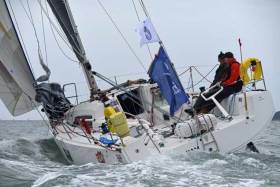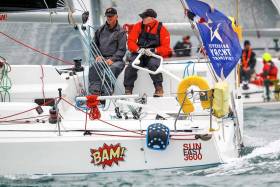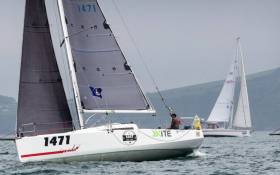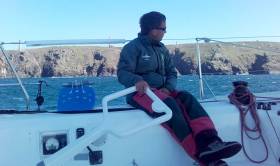Displaying items by tag: BAM!
The Irish Sunfast 3600 Bam! (Conor Fogerty and Simon Knowles) has retired from the Sevenstar Round Britain & Ireland race as of 1040 this morning, after breaking her second and only remaining masthead spinnaker halyard. Bam! was 55 miles west of Tory island, on course for St Kilda, making between 8 and 9 knots and holding her placing on sister-ships Game On and Tigris when the final breakage occurred reports W M Nixon.
With 1100 miles still to race, and at least half a day in a sheltered port with full facilities needed to effect a repair, the Howth crew really had no choice in the matter, as the other masthead halyard had broken during the night. They regretfully signalled their decision at 1100 hrs, and are now heading for a port on the north coast of Ireland.
“Put as simply as possible” said Conor Fogerty, “we’re gutted”.
Meanwhile, on-the-water leader Phil Sharp’s Class 40 Imerys Clean Energy is now well on her way along the St Kilda to Shetland islands stage, and is making 14 knots, while the two-Handed Division leader, the Figaro 2 El Velosolex (Benjamin Schwartz & Chen Jin Hao) is making 8.7 knots with 110 miles to go to St Kilda. The IRC handicap leader, Giles Redpath’s Lombard 46 Pata Negra, has just passed St Kilda, and is on a steady 11.6 knots towards the Shetlands.
Race Tracker here: http://yb.tl/rbni2018
Howth Crew Fogerty & Knowles Battle For Top Two-Handed Place In RB&I
#RB&I - Conor Fogerty and Simon Knowles in the Sunfast 3600 BAM! were yesterday evening narrowly leading the two-handed division in the RORC Sevenstar Round Britain & Ireland’s 1,805-mile marathon, writes W M Nixon.
The Howth Yacht Club duo were trying to keep cover on the Figaro 2 El Velosolex SL Energies Group (Bejamin Schwartz & Chen Jin Hao) close to the north of them, and Sunfast 3600 sister-ship Game On (Ian Hoddle & Ollie Wyatt) to their southeast as the fleet approached the massive tidal gate of Portland Bill, sailing hard on the wind.
El Velsolex to the north found freshening breeze in under Portland Island, which also got her more quickly into the Bill’s beneficial tidal shadow.
With the local sharpening of the breeze, she was able to make a clinical of job of rounding Portland Bill within a stone’s throw of the shore in slacker water, and then lengthening away into Lyme Bay on port tack.
This left BAM! with the least bad option of following, and though she too was right in on the shore at the point itself, the spark had gone from the breeze and for a while she was hung up at only 2.2 knots over the ground.
El Velosolex, meanwhile, got away into a lead of thee miles before the Irish boat got going again, but at least Game On had been left well astern, so much so that she opted to go well offshore.
Any beat westward in the English Channel will find a varying pattern of wind strengths, and through the night as the fleet slowly neared Start Point with the Mach 40.3 Corum (Nicolas Troussel) leading narrowly on the water from Phil Sharp’s Class 40 Imerys Clean Energy, at times those inshore were favoured.
But then those offshore began to get better breezes, and when the group to the north closed with the southerly group off Start Point around 7am this morning, El Velosolex had lengthened further to eight miles ahead of BAM!, but the latter was now neck-and-neck with Game On.
The two Sunfast 3600s — less than two miles apart — elected to continue the offshore tack on starboard, but at 10.29am El Velosolex tacked onto port.
This was the state of affairs at the noon position, with the Figaro still heading for the distant shore, while Game On and BAM! are holding on starboard and having a right dong, Game On ahead by 1.7 sea miles and sailing at 6.3 knots, and Bam! on her weather quarter shown as sailing at 6.4 knots. And they still have 1,670 miles to go.
Crossing the Celtic Sea from the Isles of Scilly to southwest Ireland will be interesting, as the wind is forecast to be bang on the nose at first, but backing through tomorrow. This suggests that keeping to the left will be a strategic imperative, but for how long will be anyone’s guess.
Race Tracker here: http://yb.tl/rbni2018
Conor Fogerty Credits North Sails In His Award-Winning Offshore Success
#NorthSails - New Volvo Irish Sailor of the Year Conor Fogerty has hailed North Sails Ireland’s role in his offshore success.
Following his award win last Friday, the Howth Yacht Club stalwart said: “North Sails have been a part of the Bam! story since her first launch in 2015.
“The new J2 and J5 played a key role in the OSTAR 2017 and I am looking forward to racing with the new 3Di main for the RORC Caribbean 600 Race.”
North Sails Ireland supplied the first inventory for Conor Fogerty back in 2015 with which he won his class in the 2016 RORC Caribbean 600 race. These sails were a mix of 3DL and 3Di plus nylon downwind sails.
In early 2017, for his epic OSTAR-winning attempt, North Sails Ireland supplied a new 3Di Code 2/3 reefing jib and a No 5 Radian jib for exceptionally heavy upwind work.
These sails sails did the business for Conor and Bam! as she took first place in the Gypsy Moth Class in the OSTAR.
North Sails also just supplied a new 3Di offshore main for Fogerty’s 2018 RORC Caribbean 600 Race, which starts next Monday 19 February.
Conor Fogerty Finishes OSTAR In Hugely Successful Style
#OSTAR - Ireland’s Conor Fogerty of Howth Yacht Club has burned off the last 40 miles of the OSTAR in blazing style, zooming in to Newport, Rhode Island to cross the finish line at 1545 hrs Irish time this afternoon (Monday 19 June) in his Jeanneau 3600 BAM!, writes W M Nixon.
It’s going to be some day of celebration for the determined lone skipper newly arrived in America. At the finish, 21 days 2 hours and 45 minutes after leaving Plymouth, he was just four hours behind the two-handed Open 40 Rote 66 (Uwe Rottgering & Asia Pajkowska). The only other boat ahead was the Italian Open 60 Venti di Sardegna, which finished four days ago.
As for any remotely comparable competition, we’re talking in terms of similarly sized boats – including a BAM! sister-ship – being hundreds of miles astern. The spread of the storm-depleted fleet has been remarkable.
But even more remarkable was the way that Fogerty in his much smaller racer was in there slugging it out boat-for-boat with significantly larger competitors. It has been a superhuman performance, and clearly wins Conor Fogerty the coveted Gipsy Moth Trophy.
The OSTAR transatlantic race start in Plymouth Sound today at 12:00 BST with Howth's solo sailor Conor Fogerty in the Sun Fast 3600 the sole Irish representative in the international 15–boat line–up. As Afloat.ie reported at the weekend, Forgety arrived safely in Plymouth and is ready for his race across the North Atlantic to Newport, RI, USA that is expected to last three week. See tracker below!
Bam! Ready for the Final Push in Middle Sea Race, Winner Announced By Royal Malta YC
Howth Yacht Club Middle Sea Race entry BAM has been drifting/running past Lampedusa towards the general direction of Malta/Turkey hoping for a forecasted swing and an increase in the breeze reports Anthony Doyle onboard the Dublin-based Jeanneau 3600.
The last 48 hours have been frustrating in that we made up a lot of ground across the northern coast of Sicily only to sail into another wind hole at Capo San Vito, the other side of which 2 miles away had 25ktns waiting for us.
Once we did make it through 3 hours later the lead boats in our class had disappeared again, we quickly stuck a reef in and changed down to the number 4 head sail as the breeze built from 3 Ktns to 30 Ktns in a matter of minutes. We spotted Otra Vez on the AIS heading back to Sicily and assumed that she had suffered gear failure, at least we were still in the race - there is always a positive.
Wrapped another lobster pot around the keel last night, sails down for 45 mins again to remove it.
Some highlights of the race so far
- seeing Stromboli erupting at night
- pot noodles, the "Bombay Bad Boy" went down well, "Mac and Cheese" not so much
- freeze dried dinners, chicken in black bean was especially good
- hot dogs
- being warm on the rail even when wet, makes a bit of a difference to ISORA racing
Downsides
- 1st and 2nd lobster pots on the keel resulting in dropping all sails and one of the young lads having to dive down to cut them off. Never seems to happen during the day....
- wind holes
- more wind holes
- even more wind holes
Crew are in good form, boat has been going well once we get some breeze, unfortunately the weather gods have been kinder to others this time around.
Thought for the day, "Sheep tails go down and Goat tails go up"....
Now for the final push...
Meanwhile, the Royal Malta Yacht Club announced that Vincenzo Onorato's Cookson 50 Mascalzone Latino is the overall winner of the 37th Rolex Middle Sea Race. Whilst a number of yachts are still racing, none of them have the possibility of beating Mascalzone Latino's corrected time. The Mascalzone Latino team will be awarded the Rolex Middle Sea Race Trophy and Rolex timepiece on Saturday 29 October at the prize giving ceremony to held at the Mediterranean Conference Centre in Valletta.
 Middle Sea Race winner – Mascalzone Latino Photo Rolex/Kurt Arrigo
Middle Sea Race winner – Mascalzone Latino Photo Rolex/Kurt Arrigo
This race crew was a mix of Italians and British sailors who have raced all over the world under the Mascalzone Latino banner and with great success. Last year they came agonizingly close to adding the Rolex Middle Sea Race to the honour role. In the absence of owner, Vincenzo Onorato, the boat was skippered this year by Matteo Savelli. The afterguard included Adrian Stead, Lorenzo Bressani and Branko Brcin. Ian Moore was the navigator. The sail trimmers were Leonardo Chiaruigi, Pierluigi De Felice, Stefano Ciampalini and Andrea Ballico. Daniele Fiaschi and Davide Scarpa shared the bowman duties.
Matteo Savelli: “Twelve months ago we cherished the possibility of victory but it was not to be by a nine seconds gap. But our belief in success at this event was simply delayed until this year. And now, we can say we couldn’t expect more. Everything has worked properly and the job went off without a hitch. The crew commitment was remarkable; the only regret was the lack of Vincenzo Onorato onboard."
The 2016 Rolex Middle Sea Race will be marked in the ever growing race legend as a tactically demanding one, with huge pressure on the tacticians and navigators to keep the yachts moving in the face of changing conditions. “It felt like unfinished business after coming so close to winning last year,” commented Ian Moore, continuing, “but past performance is no guarantee of future success! We knew if we wanted a chance to win this race that we would have to sail really well and get a little bit lucky with the weather. In the end, our luck held, and the guys sailed really well despite tough conditions.”
Vincenzo Onorato of Mascalzone Latino: “I am really very happy for this victory. We have quite the same crew for many many years. We won together six Worlds titles, I can’t remember how many Europeans and many of the most important major regattas in the world. The Rolex Middle Sea Race is the pinnacle of offshore racing in the Med. We were looking to win for a long time and finally we have proudly succeeded”.
Lobster Pot Snag for Howth Yacht Club's BAM! in Middle Sea Race
Howth Yacht Club crew man Anthony Doyle reports from Conor Fogerty's Jeanneau 3600 BAM! on the second day of the Middle Sea Race Race.
'We're just through the straits of Messina at approx 1530, we have what you can only call a mixed bag of a race.
Following a very light wind start in Valletta Grand Harbour we found ourselves with plenty of time to make up after the beat to Mark 2. Then the course brought us north to the South eastern side of Sicily where BAM! started hauling and passing out the competition.
Unfortunately we snagged a very complex lobster pot off Sicily which cost us at least an hour and one of the crew had to dive down to untangle the mess.
This meant that our competitors got away on different breeze but we are now reaching towards Stromboli with the A2 up doing 10 knots and a course of 330 magnetic and hope to make up some lost time.
Hopefully this is a race of many starts, and we have had ours... The skipper and crew are in great spirits and already looking forward to the next one pot wonder Paddy Gregory will rustle up for dinner this evening.
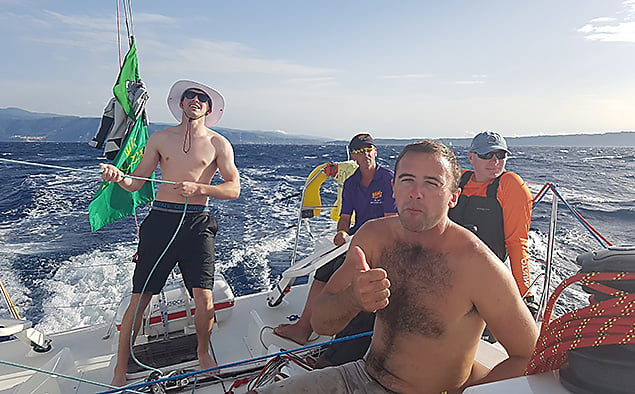 Conor Fogerty's BAM! crew have the wind behind them on day two of the Middle Sea Race. The Irish Jeanneau 3600 is racing in division IRC six with a full Howth Yacht Club crew including Simon Knowles, Paddy Gregory, Sam O'Byrne, Rob Slater and Anthony Doyle
Conor Fogerty's BAM! crew have the wind behind them on day two of the Middle Sea Race. The Irish Jeanneau 3600 is racing in division IRC six with a full Howth Yacht Club crew including Simon Knowles, Paddy Gregory, Sam O'Byrne, Rob Slater and Anthony Doyle
As Afloat.ie reported previously, Fogerty's is racing in division IRC six with a full Howth Yacht Club crew including Simon Knowles, Paddy Gregory, Sam O'Byrne, Rob Slater and Anthony Doyle. As Afloat.ie readers will recall, the doughty Irish offshore campaigner took a class win in February's RORC Caribbean 600 race.
Fogerty arrived into the Grand Harbour in Valletta last Tuesday. In the last 12 months, Bam has been sailed from Howth to the Canaries, then did the ARC race to St Lucia, then the Caribbean 600 race in February, then Conor sailed solo to the Azores, delivery from Azores back to Howth, then the Round Ireland Yacht race in June, then to the Solent for the Fastnet solo race, then the new RORC IIe D’Ouessant Race, then the Cowes to Cherbourg race and just now a delivery from Southampton to Malta. After the Middle Sea race, the boat will be wintered ashore in Malta until next spring year when she returns home.
Organised by the Royal Malta Yacht Club, the 2016 Rolex Middle Sea Race will start at 11:00hrs (CET) on the 22nd October in the spectacular Grand Harbour, Valletta, Malta.
ISORA sailors Liam Coyne and Brian Flahive are back onboard the Maltese J122 Otra Vez skippered by owner Aaron Gatt Floridia, who has sailed in Ireland's Dun laoghaire to Dingle race. It will be Coyne's fourth Middle Sea on Otra Vez. 'This will be my seventh Middle Sea race and really feeling good about this one' Coyne told Afloat.ie. Coyne managed a class win in 2014 and has previously been sixth time overall.
Also racing is INSS sailor Kenneth Rumball as part of a Maltese crew onboard the Xp44, Xpact. Rumball previously raced on Xpact in 2014 with other Irish sailors Andy Boyle, Philip Connor and Barry Hurley to second overall and first in class three onboard this X-Yacht. Hurley is back on board this year and joining them is Shane Divney of Howth Yacht Club coming back from GC32 Circuit. Laura Dillon of HYC is on Winsome. Dublin's Conor Kinsella, a co-skipper on Lynx in this year's Round Ireland, is sailing on Xpedite.
London–based Royal Irish Yacht Club sailor Niall Dowling is listed on the crew of Pata Negra, the Lombard 46 skippered by Giles Redpath


























